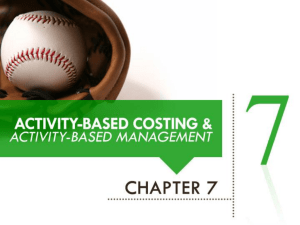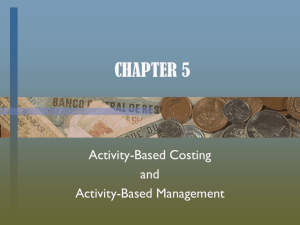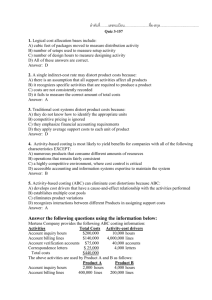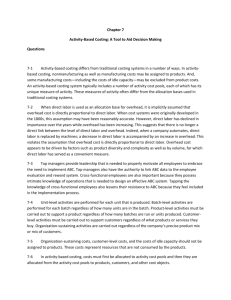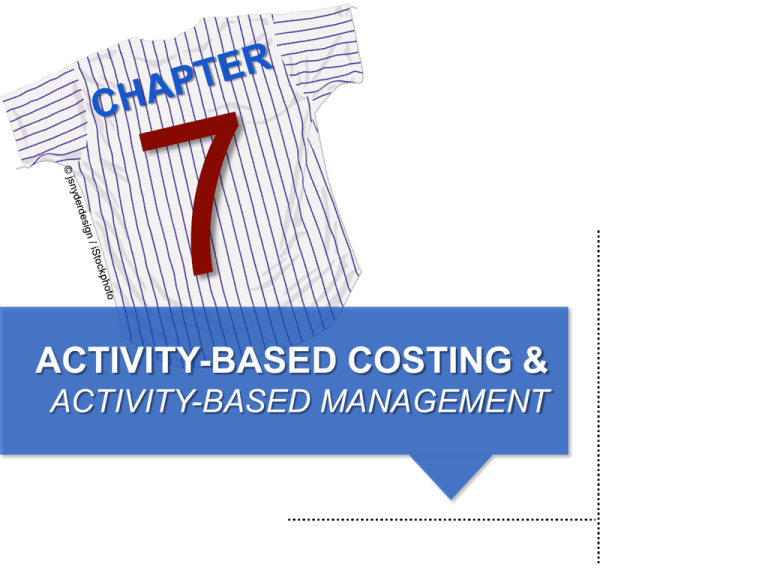
ACTIVITY-BASED COSTING &
ACTIVITY-BASED MANAGEMENT
WHAT’S UP WITH C&C SPORTS?
►
►
Costs skyrocketed
Variance analysis – 4th quarter
• Lining: $6,250 F price; $8,000 U quantity
• DL: $1,650 U rate; $14,400 U efficiency
• VOH: $26,195 U spending; $3,955 U efficiency
►
►
7
Additional jackets appear to have added
complexity to production processes
Need to better understand product costs
© Tomwang112 / iStockphoto
ACTIVITY-BASED
COSTING
Unit 7.1 Unit 7.2 Unit 7.3
71
.
TRADITIONAL COSTING AND PORS
7
ACTIVITY-BASED COSTING CONCEPT
7
WHAT’S THE COST DRIVER?
DLHS?
BATCHES
MOVED?
7
Suppose one batch of jackets takes 15 hours and three
batches of jerseys take 15 hours.
Do both products consume the same amount of
forklift resource?
TYPES OF ACTIVITIES
►
►
►
►
►
7
Unit-level
Batch-level
Product-level
Customer-level
Organization-level
TYPES OF ACTIVITIES
►
Unit-level
• Incurred by production or acquisition of a single unit of product or
the delivery of a single unit of service
►
Batch-level
• Incurred when a group of similar things are made, handled or
processed at the same time
►
Product-level
• Incurred in support of different products or processes
►
Customer-level
• Incurred to support and sustain a specific customer
►
7
Organization-level
• Incurred to support and sustain a business unit
UNIT LEVEL ACTIVITIES
►
►
►
7
Volume or level of activity is proportional to the
number of units produced
Costs incurred to perform these activities can be
allocated using traditional methods such as DLH
or MH
C&C – operating sewing machines
BATCH-LEVEL ACTIVITIES
►
►
►
7
Volume or level of activity is proportional to the
number of batches produced
Costs are incurred when a group of similar things
are made or handled at the same time
C&C – Moving batches of products; cutting fabric
PRODUCT-LEVEL ACTIVITIES
►
►
►
7
Activities that support the production and sale of
individual products
Related to all units and batches produced,
regardless of volume
C&C – creating patterns for new products
CUSTOMER LEVEL-ACTIVITIES
►
►
►
►
7
Activities performed to support specific customers
Not dependent on the number of units or products
sold to that customer
Costs for these resources do not affect product
cost
C&C – making sales calls
ORGANIZATION-SUSTAINING ACTIVITIES
►
►
►
►
7
Activities performed to maintain the plant facility
and provide managerial infrastructure
Not dependent on the volume of production, just
the number of facilities maintained
The cost of these resources is not allocated to
products
C&C – renting factory space
COMPARISON OF GAAP AND ABC COSTS
Cost Category
GAAP-Based Product Cost
Activity-Based Product Cost
Direct Materials
✔
✔
Direct Labor
✔
✔
NOTICE: Under ABC, organization-level
costs are not allocated
to products
Unit-Level
✔
✔
Manufacturing Overhead
Batch-Level
✔
✔
Product-Level
✔
✔
NOTICE:
Organization-Level
Under traditional
costing, S&A
✔
expenses are not allocated to products
S&A Expense
Unit-Level
✔
Batch-Level
✔
Product-Level
✔
7
© Tomwang112 / iStockphoto
DEVELOPING ACTIVITY-BASED
PRODUCT COSTS
Unit 7.1 Unit 7.2 Unit 7.3
7.2
FIVE STEPS TO IMPLEMENT ABC
►
►
►
►
►
7
Identify activities
Develop activity cost pools
Calculate activity cost pool rates
Allocate costs to products or services
Calculate unit product costs
ACTIVITY-BASED COSTING (STEPS 1 & 2)
7
See Exhibit 7-5 for details of costs to activity pools
ACTIVITY-BASED COSTING (STEP 3)
See Exhibit 7-6 for details of activity cost pool rates
7
ACTIVITY-BASED COSTING (STEP 4)
7
See Exhibit 7-7 for details of cost
allocations to each product
ACTIVITY-BASED COSTING (STEP 5)
7
COMPARISON OF TRADITIONAL & ABC COSTING
7
UNDER TRADITIONAL COSTING SYSTEMS…
►
►
►
7
Small volume jobs are typically under-costed
Large volume jobs are typically over-costed
In ABC, this is corrected as batch-related and
product-level costs are allocated using appropriate
batch and product cost drivers
© Tomwang112 / iStockphoto
ACTIVITY-BASED
MANAGEMENT
Unit 7.1 Unit 7.2 Unit 7.3
7.3
MANAGEMENT SAYS…
Labor costs are too high. What’s your first
reaction?
Reduce
headcount
7
THE KEY IS ACTIVITY MANAGEMENT
LOOK AT THE ACTIVITIES THAT USE LABOR RESOURCES
►
►
►
►
7
Inefficient production processes
Poor facilities layout
Non-value added activities
Untrained workforce
WHAT ADDS VALUE TO THE PRODUCT?
►
►
►
►
7
Look at your activities
If customers are willing to pay for an activity, it is
value-added
If customers aren’t willing to pay for it, the activity
is non-value-added
Eliminate the non-value-added activities and the
related resources to reduce costs
HOW IS ABC INFORMATION USED?
7
An ABC analysis may reveal interesting
information about product profitability.
Source: Activity Based Costing: How ABC is Used in the Organization, Copyright 2005,
SAS Institute Inc., Cary, NC. All Rights Reserved. Reproduced with permission of SAS
Institute Inc., Cary, NC
TRADITIONAL VS ABC PROFITABILITY
7
DOES ABC CHANGE PRODUCTION COSTS?
NO
ABC re-allocates costs based on the activities
consumed by the products
7
ACTIVITY-BASED COSTING RECAP
►
►
►
►
7
Recognizes that various activities and cost levels
exist
Gathers costs into related cost pools
Uses multiple cost drivers to assign costs to
products and services based on the consumption
of resources by activities
ABC focuses on attaching costs to products and
services based on the activities used to produce,
perform, distribute or support those products and
services

